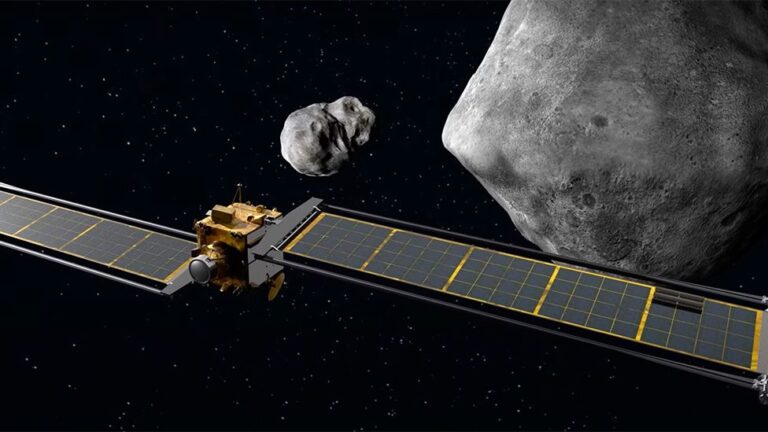A recent collision between an asteroid and a NASA spacecraft revealed an odd behaviour in the asteroid, according to astronomers. Students in high school learned about the incident while researching NASA’s DART programme in the Didymos System.
The asteroid Dimorphos is displaying unexpected behaviour as a result of its collision with a NASA rocket last year, according a study that was published in the academic journal “The New Scientist.”
According to New Scientist, NASA’s main goal was to shorten the space rock’s orbit around its parent asteroid. Even though the mission was successful, Dimorphos’ orbit has been becoming smaller.

According to the study, NASA’s DART spacecraft—short for Double Asteroid Redirection Test—intentionally collided with a space rock that was about 580 feet broad (177 metres) in diameter. Dimorphos changed its orbit strangely after this encounter, prompting scientists to label its actions as “weird.”
According to The New Scientist, the struck asteroid Dimorphos is still orbiting the sun normally but is now revolving in an unexpected way.
At first, NASA thought that Dimorphos was unaffected by the DART mission. This changed, though, when NASA’s projections were refuted by research conducted by a high school teacher called Jonathan Swift and his students.
After the crash, California high school teacher Swift and his students were the first to notice changes in Dimorphos’s orbit. They investigated the asteroid with their 2.3-foot-long telescope.
Dimorphos’ orbital speed decreased by 33 minutes a few weeks following the collision. According to Swift and his pupils, the asteroid had been slowing down since the encounter and was doing so at a pace of one minute each period.
The fact that Swift and his team’s estimates didn’t exactly match NASA’s measurements, however, shocked them even more. They saw a 34-minute difference rather than a 33-minute delay.
“The number we got was slightly larger, a change of 34 minutes,” Jonathan Swift told New Scientist. That was unpleasant levels of inconsistent.
In June, Swift delivered his research to the American Astronomical Society. Dimorphos had actually continued to slow down following the hit, according to NASA’s DART team. Their estimates, however, suggested a further slowing of about 15 seconds, not a full minute. After the impact, the slowdown’s rate had reached a steady state.
Due to the accident, Dimorphos slowed down in order to comprehend what was occurring. Some of its components disintegrated and spread along its normal route as a result of the impact. Dimorphos slowed whenever it came upon one of these stony pieces. Once it had overcome all of these challenges and cleared its way, it continued to move smoothly without altering its pace for approximately a month until settling into an equilibrium.
We may learn more about this occurrence in 2026 when the European Space Agency’s mission, “Hera,” is slated to arrive at Dimorphos for a thorough examination, even though the DART team has not yet made public its formal report on these results.
The first-ever planetary defence test is called DART. It is intended to adjust an asteroid’s motion in order to show how we might lessen the risks that asteroid collisions could pose to Earth. In order to better comprehend celestial objects, DART collides a spacecraft with an asteroid (the moonlet of the binary asteroid system Didymos). This gives important information on the mechanics of asteroid deflection. If it is effective, DART establishes a model for international collaboration in planetary defence. In order to protect our world from probable asteroid strikes, it is a preventative measure.
5 comments
Rattling superb info can be found on blog.?
Hiya very cool blog!! Guy .. Beautiful .. Wonderful .. I’ll bookmark your web site and take the feeds additionally…I am happy to search out a lot of useful info right here in the publish, we need work out extra strategies in this regard, thank you for sharing.
Hi! I could have sworn I’ve visited this blog before but after browsing through a few of the posts I realized it’s new to me. Regardless, I’m definitely pleased I came across it and I’ll be bookmarking it and checking back often!
Greetings! Very useful advice in this particular post! It’s the little changes that produce the biggest changes. Thanks a lot for sharing!
I like it when people come together and share views. Great blog, keep it up.